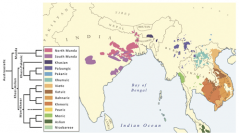

 Comptes Rendus Palevol
11 (2-3) - Pages 117-132
Comptes Rendus Palevol
11 (2-3) - Pages 117-132Linguistic palaeontology permits the identification of two language families whose linguistic ancestors pose the likeliest candidates for the original domesticators of rice, viz. Hmong-Mien and Austroasiatic. In the 2009 model, the ancient Hmong-Mien was identified as the primary domesticators of Asian rice, and the ancient Austroasiatics as the secondary domesticators. Recent rice genetic research leads to the modification of this model for rice domestication, but falls short of identifying the original locus of rice domestication. At the same time, the precise whereabouts of the Austroasiatic homeland remains disputed. Linguistic evidence unrelated to rice agriculture has been adduced to support a southern homeland for Austroasiatic somewhere within the Bay of Bengal littoral. The implications of new rice genetic research are discussed, the linguistic palaeontological evidence is reassessed, and an enduring problem with the archaeology of rice agriculture is highlighted.
Ethnolinguistic identity, Rice, Asia